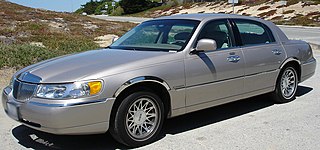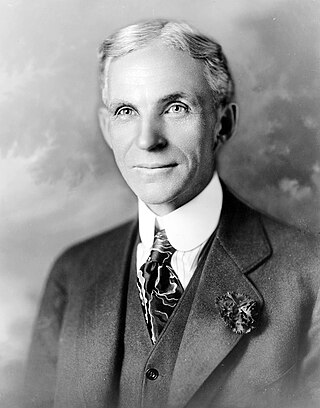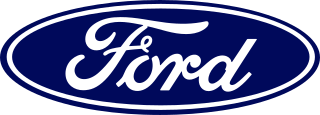
Lincoln Motor Company, or simply Lincoln, is the luxury vehicle division of American automobile manufacturer Ford. Marketed among the top luxury vehicle brands in the United States, until 2020, Lincoln was positioned closely against its General Motors counterpart Cadillac; however, beginning with the 2021 model year, they only offer SUV and crossover vehicles.

Edsel is a discontinued division and brand of automobiles that was produced by the Ford Motor Company in the 1958 to 1960 model years. Deriving its name from Edsel Ford, son of company founder Henry Ford, Edsels were developed in an effort to give Ford a fourth brand to gain additional market share from Chrysler and General Motors. Established as an expansion of the Lincoln-Mercury Division to three brands, Edsel shared a price range with Mercury; the division shared its bodies with both Mercury and Ford.

Mercury was a brand of mid-priced automobiles produced by American manufacturer Ford Motor Company between 1938 and 2011 with 1939 being the first model year. It stood as its own line within Ford until 1945, and thereafter formed half of Ford's Lincoln-Mercury Division. Created by Edsel Ford in 1938 to bridge the gap between the Ford and Lincoln model lines, its principal competition was General Motors' Buick and Oldsmobile divisions, and Chrysler Corporation's DeSoto and Chrysler brands.

The Lincoln Town Car is a model line of full-size luxury sedans that was marketed by the Lincoln division of the American automaker Ford Motor Company. Deriving its name from a limousine body style, Lincoln marketed the Town Car from 1981 to 2011, with the nameplate previously serving as the flagship trim of the Lincoln Continental. Produced across three generations for thirty model years, the Town Car was marketed directly against luxury sedans from Cadillac and Chrysler.

The Ford CD3 platform is a Ford midsize car automobile platform. It was designed by Mazda. The platform is designed for either front, all-wheel drive or Ford's hybrid powertrain.

The Ford D3 platform is an automobile platform assembled by Ford Motor Company. In production between the 2005 and 2019 model years, the D3 platform is the fifteenth generation of full-size cars produced by Ford in North America. Marking the adoption of unibody chassis construction, a transverse engine configuration, front-wheel drive, all-wheel drive, and the lack of a V8 engine, the D3 platform is derived from the 1998-2016 Volvo P2 architecture. Since 2008, the related D4 platform has served as a basis for crossover SUVs.

The Ford Panther platform was an automobile platform that was used by Ford Motor Company from the 1979 to 2012 model years. Following the downsizing of the General Motors B-bodies and C-bodies by two years, the Panther platform marked the end of production of sedans unencumbered by downsizing. Originally slated for discontinuation during the early 1980s, the Panther architecture was used for 33 model years, making it one of the longest-produced platforms in North American automotive history.

A knock-down kit is a collection of parts required to assemble a product. The parts are typically manufactured in one country or region, then exported to another country or region for final assembly.

William Clay Ford Jr. is an American businessman, serving as executive chair of Ford Motor Company. The great-grandson of company founder Henry Ford, Ford joined the board in 1988 and has served as chair since January 1999. Ford also served as the president, CEO, and COO until turning over those roles to former Boeing executive Alan Mulally in September 2006. Ford is also the vice chairman of the Detroit Lions NFL franchise. Ford serves as a chairman of the United States-Mexico Chamber of Commerce.

The Ford Wixom Assembly Plant was a Ford Motor Company manufacturing facility in Wixom, Michigan, with production reaching 6,648,806 over the fifty years it was operational (1957–2007).

The Oakville Assembly Complex is a Ford Motor Company of Canada automobile factory in Oakville, Ontario, spanning 487 acres. This landmark occupies the same site as, and combines, the former Ontario Truck plant and Oakville Assembly Plant. Clearly visible from the Queen Elizabeth Way and the Lakeshore West GO Train line, it relies on the nearby railway service to transport parts and vehicles throughout the country.
The automotive industry in India is the fourth-largest by production in the world as per 2022 statistics. As of 2023, India is the 3rd largest automobile market in the world in terms of sales. In 2022, India became the fourth largest country in the world by the valuation of its automotive industry.

Kansas City Assembly Plant (KCAP) is a Ford Motor Company automobile assembly facility which produces the Ford F-150 and the Ford Transit. It is located in Claycomo, Missouri, United States, about 10 miles (16 km) northeast of Kansas City, Missouri. It consists of 4.7 million square feet (440,000 m2) of production space and employs approximately 9,468 hourly workers represented by the United Auto Workers Local 249. It is the largest car manufacturing plant in the United States in terms of vehicles produced.

St. Thomas Assembly was an automobile plant located in Southwold, Ontario, Canada, close to the Talbotville community and the nearby city of St. Thomas. The 2,600,000 sq ft (240,000 m2) facility, situated on a 635 acres (2.57 km2) site, opened in 1967, building the Ford Falcon. Flexible fuel vehicles (FFV) capable of operating on ethanol fuel were manufactured there during the later years of the assembly plant. Ford's plans for sustainability and reduction of fossil fuel consumption relied on the St. Thomas Plant and its Lincoln Town Car vehicles for years. It also produced the final Mercury vehicle, a Mercury Grand Marquis, after Ford decided to discontinue the Mercury brand after the 2011 model year.

Mahindra & Mahindra Limited (M&M) is an Indian multinational automotive manufacturing corporation headquartered in Mumbai. It was established in 1945 as Mahindra & Mohammed and later renamed Mahindra & Mahindra. Part of the Mahindra Group, M&M is one of the largest vehicle manufacturers by production in India. Its unit, Mahindra Tractors, is the largest manufacturer of tractors in the world by volume. It was ranked 17th on a list of top companies in India by Fortune India 500 in 2018. Its major competitors in the Indian market include Maruti Suzuki India and Tata Motors.

The Ford Motor Company is an American automaker, the world's fifth largest based on worldwide vehicle sales. Based in Dearborn, Michigan, a suburb of Detroit, it was founded by Henry Ford on June 16, 1903. Ford Motor Company would go on to become one of the largest and most profitable companies in the world. The largest family-controlled company in the world, the Ford Motor Company has been in continuous family control for over 110 years. Ford now encompasses two brands: Ford and Lincoln. Ford once owned 5 other luxury brands: Volvo, Land Rover, Jaguar, Aston Martin, and Mercury. Over time, those brands were sold to other companies and Mercury was discontinued.

Ford India Private Limited is a subsidiary of Ford Motor Company for its operations in India. Ford India Private Limited's headquarter is located in Sholinganallur, Chennai, Tamil Nadu. Ford also had operated integrated manufacturing facilities in Sanand, Gujarat. On September 9, 2021, Ford has exited the Indian market as it failed to keep up with the competition, and other global economic factors had led to reduction in demand. On 8 August 2022, Ford announced it would be selling its manufacturing plant in the western state of Gujarat for INR 7.26 billion to Tata Motors. Since 2021, Ford India has focused on the businesses of supporting a service network, import and distribution of automotive parts, and the sale of extended warranties.
Hermosillo Stamping and Assembly is a Ford Motor Company-owned automobile assembly facility located in Hermosillo, Sonora, Mexico. The facility currently assembles Ford Bronco Sport and Ford Maverick (2022) models for the North American market. The facility, which began production in 1986, employs 1,500 people and covers a floor space of approximately 1,500,000 sq ft (140,000 m2).

Ford Motor Company is an American multinational automobile manufacturer headquartered in Dearborn, Michigan, United States. It was founded by Henry Ford and incorporated on June 16, 1903. The company sells automobiles and commercial vehicles under the Ford brand, and luxury cars under its Lincoln brand. Ford also owns a 32% stake in China's Jiangling Motors. It also has joint ventures in China, Taiwan, Thailand, and Turkey. The company is listed on the New York Stock Exchange and is controlled by the Ford family; they have minority ownership but the majority of the voting power.
The Ford Romeo Engine Plant was a Ford Motor Company automobile plant located at 701, 32 Mile Road in Romeo, Michigan. The plant began in 1967 as a small Ford industrial equipment plant, and in 1973 it was expanded 10-fold to become an engine and tractor plant. From 1973 to 1988, tractor engines and parts, farm implements, and assembled tractors were made there. Shortly after 1990, the first 4.6 2-valve per cylinder V-8 engine was produced for the Lincoln Town Car. Most recently, it manufactured the Ford Modular engine. On December 30, 2022 it was announced the plant had permanently closed and employees were being offered either a buyout or transfer to another Ford factory.
















